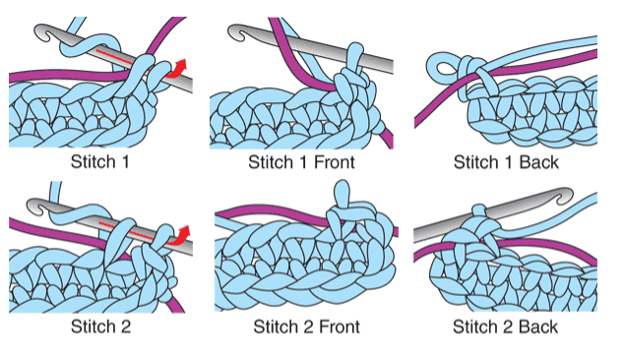Crochet Colorwork
There are many types of crochet colorwork: intarsia, Fair Isle, tapestry, etc. Intarsia is worked when you have large sections of color. Each section will be worked using a separate ball of yarn. Fair Isle colorwork uses more intricate stitch patterns with short color change sequences. You will carrythe yarn behind the work until needed again. These carried strands are called floats. In tapestry crochet, you work more intricate stitch patterns as well but you work over the color not in use until needed again. At the end of this page, you will find more details about tapestry crochet.
Most colorwork patterns are worked from charts with color coded squares. Each square represents a stitch and its color. If you’re working in rows, you will read the right-side rows from right to left across the chart and the wrong-side rows from left to right. If you’re working in the round, you will read all rows from right to left.
Before beginning to use the different colorwork techniques, you need to understand color. Making good color choices will result in a finished product that you will truly love and cherish.
Using the Color Wheel to Select Colors
If you are on the fence about what colors you would like to use in your project, a color wheel is a useful tool, especially if you decide you really enjoy colorwork. It also allows you to not be locked into only the color options shown in the pattern. Many times a project catches your eye because of the color combination. Other times you may really love the patterning, but don’t know where to begin to change the colors to something more to your liking. Here are some helpful ways to use the color wheel when deciding colors for your project.
Locate the main color you'd like to use for your project on the wheel.
Blending colors can be chosen from the two wedges to the left and two wedges to the right of the main color. These will create very subtle color changes in your project. Contrasting colors are directly across from the main color. Picking a contrasting color will add a real eye-catching pop to your project.
Triad colors can be added by choosing the colors that create a triangle with the main color. For example, if your main color is blue, triad colors are yellow and red. This color combo would also be very vibrant and eye-catching.
If you wish to choose unusual color schemes, choose colors that are the same values. All colors on the wheel are numbered according to value, and you'll create gorgeous combinations by combining colors from any value group.
For an exciting color scheme, choose black, gray, navy, brown or white and accent it with one or more vivid colors.
Choose colors that reflect the personality of your piece. Yellows are cheerful and bright. Reds are passionate and aggressive. Blues are calm and cool. Purples are regal and evoke the night sky. Oranges are warm and cozy. Greens, depending on whether they are more blue or yellow, can be cool or vibrant.
Tapestry Crochet
Tapestry crochet is a form of colorwork characterized by working over the color(s) not in use until needed again. It creates a clean, tidy fabric with no yarn strands visible on the wrong side. It is generally worked in single crochet with a tight tension to help hide the color you are working over. Work in one color, then bring up and work with the new color when needed, working over the old color until needed again.
To carry the yarn that’s not in use, once you change colors, lay the old color along the top of the stitches you are going to be working into with the new color. Single crochet over the old color of yarn, using your thumb to help guide the yarn strand as you work, effectively encasing the old color and hiding it inside the single crochet stitches of the new color.
If this is done properly, the color being worked over will not be visible on either side of your work. This requires firm, even tension as you work.
To illustrate this with a simple pattern, begin by working a row of foundation chains, then work a single crochet in the 2nd chain from the hook and in each remaining chain across. Now rotate the piece to work in the unused loops on the opposite side of the foundation chains, single crochet in the remaining loop of each chain across.
*Carrying the 2nd color along the top of the single crochet being worked in, insert the hook in the indicated stitch, yarn over, pull the loop through, yarn over (see Stitch 1), pull through both loops (see Stitch 1 Front and Stitch 1 Back), repeat from the * across to the stitch in which you would like to change colors (see Stitch 2, Stitch 2 Front and Stitch 2 Back).


When you’re ready to change to the 2nd color, leave the last 2 loops of the working color on the hook, yarn over with the 2nd color (see Stitch 3) and pull the loop of the 2nd color through those 2 loops (see Stitch 3 Front and Stitch 3 Back).


Carrying the first color on top of the stitches as you go (see Stitch 4), continue working single crochet in the 2nd color (see Stitch 4 Front and Stitch 4 Back).


Change colors back to first color as you previously changed colors (see Stitch 5) and continue the round per the pattern instructions for the desired design, carrying the unworked color on top of the stitches (see Stitch 5 Front and Stitch 5 Back).


